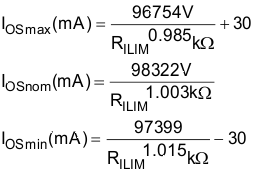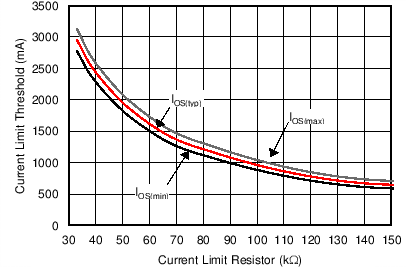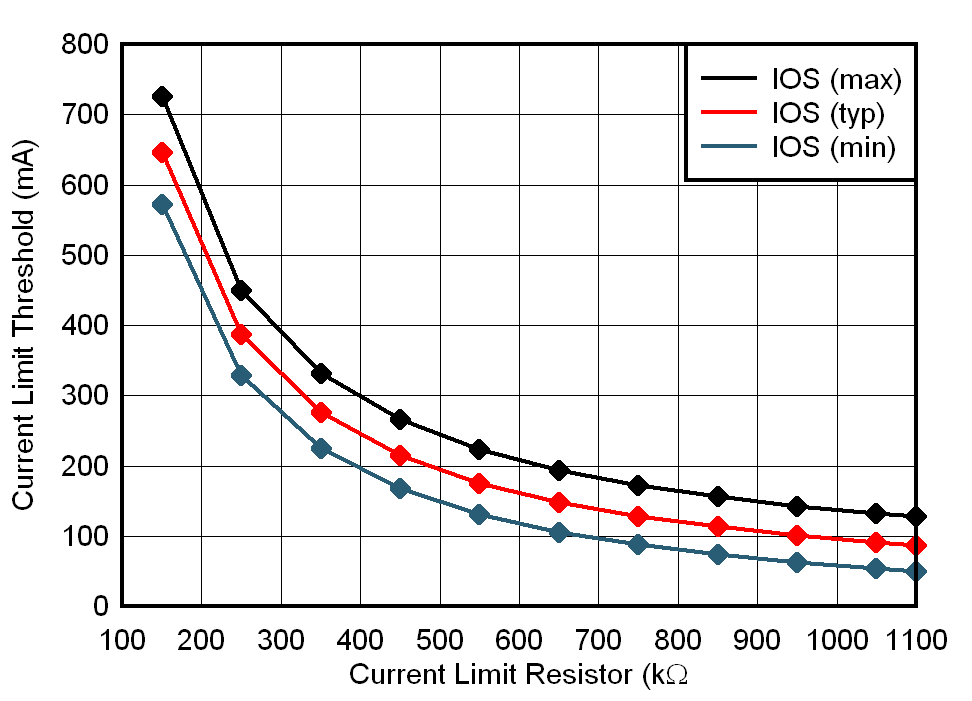JAJSIO9E March 2014 – June 2021 TPS25200
PRODUCTION DATA
- 1 特長
- 2 アプリケーション
- 3 概要
- 4 Revision History
- 5 Pin Configuration and Functions
- 6 Specifications
- 7 Parameter Measurement Information
- 8 Detailed Description
- 9 Application and Implementation
- 10Power Supply Recommendations
- 11Layout
- 12Device and Documentation Support
- 13Mechanical, Packaging, and Orderable Information
パッケージ・オプション
メカニカル・データ(パッケージ|ピン)
- DRV|6
サーマルパッド・メカニカル・データ
- DRV|6
発注情報
9.2.2.3 Programming the Current-Limit Threshold
The overcurrent threshold is user programmable via an external resistor. The TPS25200 uses an internal regulation loop to provide a regulated voltage on the ILIM terminal. The current-limit threshold is proportional to the current sourced out of ILIM. The recommended 1% resistor range for RILIM is 33 kΩ ≤ RILIM ≤ 1100 kΩ to ensure stability of the internal regulation loop. Many applications require that the minimum current limit is above a certain current level or that the maximum current limit is below a certain current level, so it is important to consider the tolerance of the overcurrent threshold when selecting a value for RILIM. The current-limit threshold equations (IOS) in Equation 1 approximate the resulting overcurrent threshold for a given external resistor value RILIM. See the Electrical Characteristics table for specific current limit settings. The traces routing the RILIM resistor to the TPS25200 must be as short as possible to reduce parasitic effects on the current-limit accuracy.
RILIM can be selected to provide a current-limit threshold that occurs 1) above a minimum load current or 2) below a maximum load current.
To design above a minimum current-limit threshold, find the intersection of RILIM and the maximum desired load current on the IOS(min) curve and choose a value of RILIM below this value. Programming the current limit above a minimum threshold is important to ensure start up into full load or heavy capacitive loads. The resulting maximum current-limit threshold is the intersection of the selected value of RILIM and the IOS(max) curve.
To design below a maximum current-limit threshold, find the intersection of RILIM and the maximum desired load current on the IOS(max) curve and choose a value of RILIM above this value. Programming the current limit below a maximum threshold is important to avoid current limiting upstream power supplies causing the input voltage bus to droop. The resulting minimum current-limit threshold is the intersection of the selected value of RILIM and the IOS(min) curve. See Figure 9-4 and Figure 9-5 .

Where 33 kΩ ≤ RILIM ≤ 1100 kΩ.

| 33 kΩ ≤ RILIM ≤ 150 kΩ |

| 150 kΩ ≤ RILIM ≤ 1100 kΩ |